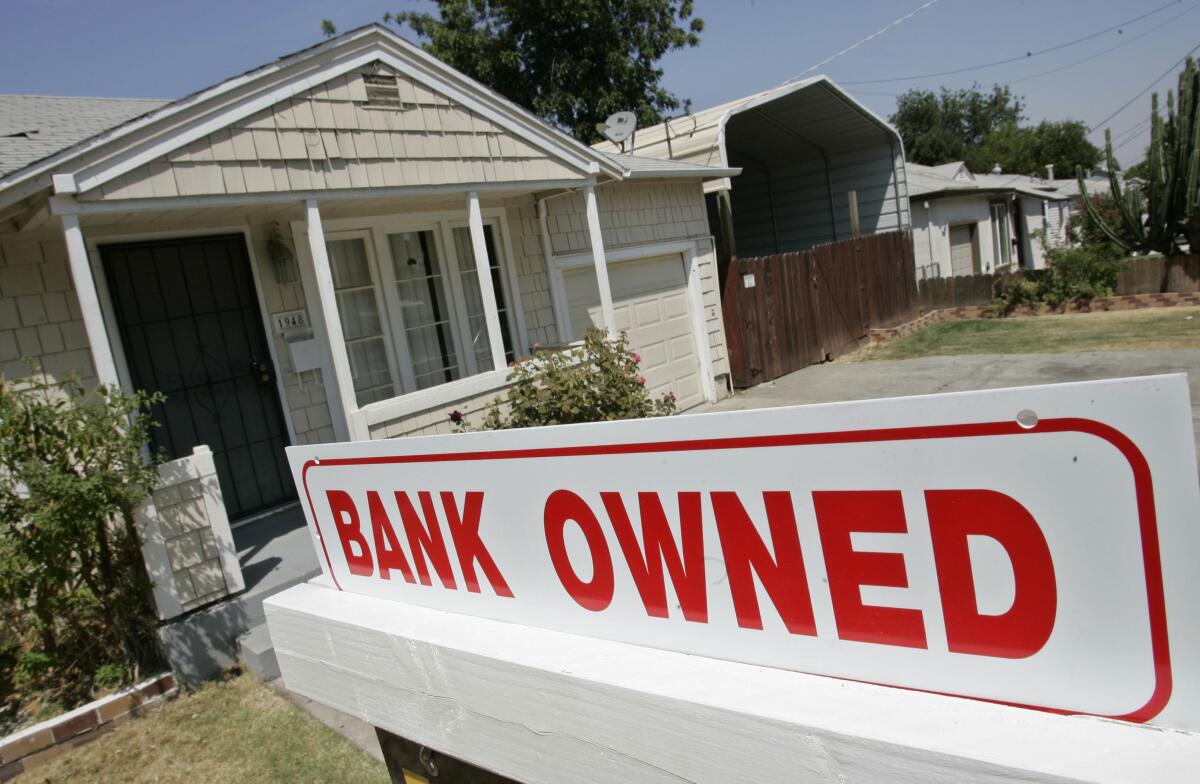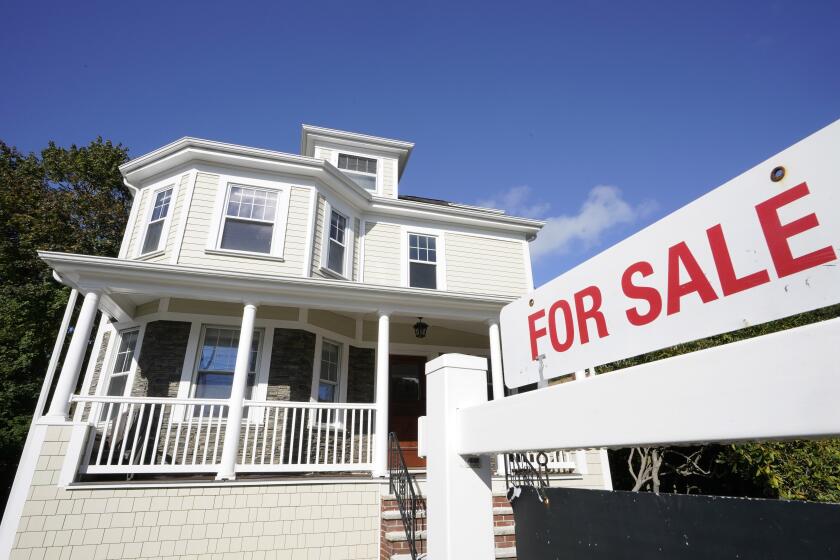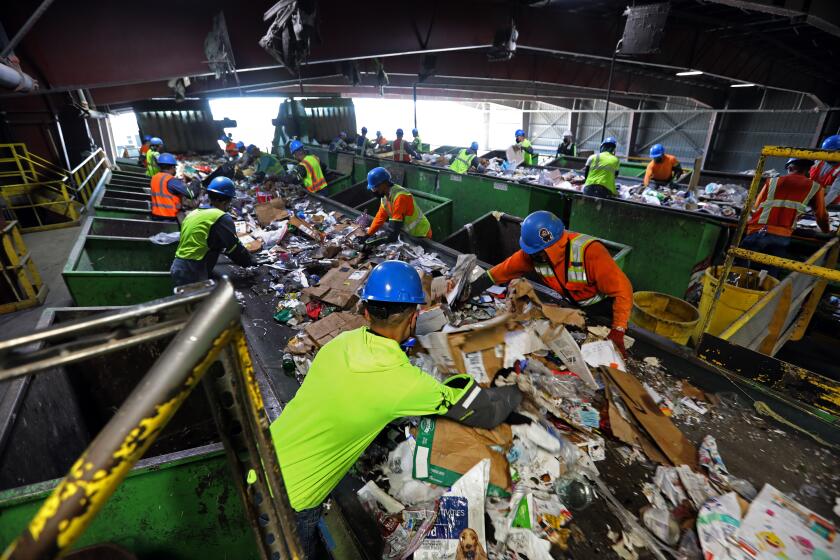California offers help for more homeowners who missed mortgage or tax payments

- Share via
The California Mortgage Relief program is expanding its reach yet again, offering aid to more homeowners who’ve fallen behind on their payments since the pandemic began.
The program offers up to $80,000 to low- and moderate-income homeowners who have missed at least two mortgage payments because of a pandemic-related financial hardship. These homeowners can also obtain up to $80,000 for overdue property taxes.
The state previously limited aid to homeowners who had missed payments by March 1, 2023. But the California Housing Finance Agency’s Homeownership Relief Corp. hasn’t exhausted the $1 billion in federal funds it received for the program, so aid is now available to those who missed at least two mortgage payments or one property tax payment by Aug. 1.
“We’ve heard from Californians who initially didn’t believe this funding was real,” Rebecca Franklin, president of the CalHFA Homeownership Relief Corp., said in a statement. “And so many vulnerable homeowners who were able to save their home and continue building generational wealth for their families.”
“Now that we have crossed the halfway point, California homeowners should apply right away because these funds are limited,” Franklin added. “Over 20,000 homeowners have already gotten help with late mortgage payments, missed property taxes and partial claims loan deferrals taken during the pandemic.”
Here are more details on who’s eligible, how to apply and what’s covered.
It is possible to use funds from retirement accounts to buy a house. But withdrawals could bring taxes and penalties.
Who qualifies for relief?
Under federal law, households earning up to 150% of the median income in their county who suffered a pandemic-related financial hardship are eligible for up to $80,000 in relief. According to a calculator on the program’s website, 150% of the median income in L.A. County is $132,450 for a single individual and $189,150 for a family of four.
The program defines a financial hardship as either reduced income or increased living expenses stemming from the COVID-19 pandemic. According to its website, qualifying expenses include “medical expenses, more people living in the household or costs for utility services.”
There are a few more limitations, however:
- The home in question must be your principal residence.
- You may own only one property, although it may have up to four units on it.
- If you’ve already paid off your mortgage or tax debt, you can’t recoup that money by applying for state aid.
- You will not qualify if your mortgage is a “jumbo” loan bigger than the limits set by Fannie Mae and Freddie Mac.
- You can’t obtain the state’s help if you have more than enough cash and assets (other than retirement savings) to cover your mortgage or tax debt yourself.
- Your mortgage servicer must be participating in the program.
Californian’s recycling habits are changing for the better, but there’s still plenty of room for improvement.
What kinds of help are available?
The program isn’t limited to helping people with mortgage and property tax debt. Funds also can be used for:
A second shot of relief. The mortgage relief program was originally seen as one-time-only assistance. Now, however, California homeowners who’ve already received help can apply for more if they have missed more payments and remain eligible. No household may collect more than $80,000 over the course of the program.
Reverse mortgages. Homeowners with reverse mortgages can apply for help with missed property tax or home insurance payments.
Partial claim second mortgages and deferrals. This applies to certain borrowers who fell behind on loans backed by the Federal Housing Administration, the U.S. Department of Agriculture or the Department of Veterans Affairs. Rather than demanding larger payments to cover the past-due amount, the agencies encouraged lenders to split off the past-due portion into a second, interest-free mortgage called a partial claim. That way, a borrower could stay current by paying just their usual monthly payment.
The partial claim second mortgage could be ignored until the house was sold, the mortgage was refinanced or the first mortgage was paid off, at which point the partial claim would have to be paid in full. In the meantime, it’s a real debt that affects the borrower’s ability to obtain credit.
Similarly, some lenders offered deferrals that bundled the missed payments into a sum that was tacked on to the end of the loan. Borrowers wouldn’t face higher monthly payments, but they would have to pay off the deferred amount (a “balloon payment”) when they refinanced, sold their house or reached the end of their loan.
The mortgage relief program offers up to $80,000 to pay all or part of a COVID-related partial claim or deferral received during or after January 2020.
In a tentative settlement, the City of Los Angeles has agreed to repay customers who were charged too much for sewer service from May 2016 to June 2022.
How do you apply?
Applications are available only online at camortgagerelief.org. For help filling one out, you can call the program’s contact center at (888) 840-2594, where assistance is available in English and Spanish.
If you don’t have access to the internet or a computer, you can ask a housing counselor to assist you. For help finding a counselor certified by the federal Department of Housing and Urban Development, call (800) 569-4287. You may also get help from the company servicing your mortgage.
The online application process starts with questions to determine your eligibility. If you meet the state’s criteria, you can then complete an application for funds. Here’s where you will need some paperwork to establish how much you earn and how much you owe.
According to the program’s website, among the documents you will need to provide are a mortgage statement, bank statements, utility bills and records that show the income earned by every adult in your household, such as pay stubs, tax returns or a statement of unemployment benefits. If you don’t have access to a digital scanner, you can take pictures of your documents with your phone and upload the images.
The site provides links to the application in English, Spanish, Chinese, Korean, Vietnamese and Tagalog.
With another heat wave straining California’s electrical grid, it’s a good time to think about how to keep the power on during a blackout. There’s no cheap fix.
When will the program end?
The state will continue to offer help to homeowners who became delinquent because of COVID-related issues until it has spent all $1 billion it received from the American Rescue Plan Act. According to the program’s data dashboard, a little more than half of the federal funds have been awarded, providing an average of $25,648 to more than 20,000 households.
More than half the money has gone to homeowners whose incomes are 30% or less of the area median. About 52% has gone to Latino and Black Californians, who together make up about 29% of the state’s homeowners.
The money will be awarded on a first-come, first-served basis, with one important exception: 40% of the aid must go to “socially disadvantaged homeowners.” Those are residents of the neighborhoods most at risk of foreclosure, based on the Owner Vulnerability Index developed by UCLA’s Center for Neighborhood Knowledge.
About The Times Utility Journalism Team
This article is from The Times’ Utility Journalism Team. Our mission is to be essential to the lives of Southern Californians by publishing information that solves problems, answers questions and helps with decision making. We serve audiences in and around Los Angeles — including current Times subscribers and diverse communities that haven’t historically had their needs met by our coverage.
How can we be useful to you and your community? Email utility (at) latimes.com or one of our journalists: Jon Healey, Ada Tseng, Jessica Roy and Karen Garcia.
More to Read
Sign up for Essential California
The most important California stories and recommendations in your inbox every morning.
You may occasionally receive promotional content from the Los Angeles Times.











